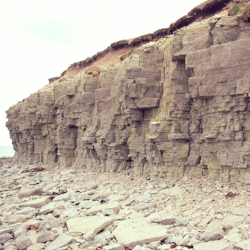
Vigilante Gulch, Montana
When asked Josh Saksa, an avid Montana rock hound where he would suggest to go searching for rocks in 2017, he immediately said,
“I would go Hyalite Canyon for Hyalite opals, White Earth Campground for agates (we got selenite instead) and Vigilante Gulch for fossils.” I immediately put them on the calendar but had no idea I would not get a guide or help with the excursions.
I had to teach myself if I wanted to go. Hyalite Canyon was gorgeous, but the trip was difficult for the most avid hiker and the snow above the tree line was prohibitive. The scenery was magnificent. White Earth Campground was amazing because a canoe sailed smoothly along the shoreline not to reveal agate at various spots, but rather exposed a large scale selenite find of gigantic proportions. But a trip to Vigilante Gulch rescheduled in combination with crystal searching in Elliston the following weekend will combine two weekends together to produce the experience of his suggestion along with that of Rollin Personnette.
In the meantime it seemed appropriate to utilize this time to pack in some fossil finding facts for when you might like to plan a trip to this wealth of an area for fossils yourself.
When prodded for information later, Josh said that in prep for going up Vigilante Gulch a research of the Madison Limestone formation was needed. Well, I checked it out and found that Montana was formed just like some adjoining states with rich rock formations that divulge fossils for the outdoor recreational prospector in search of fossils.
Sooner or later when the means to travel arrives, certainly this area will be scoured and the advice of an expert to sit in one spot and start with the eyes searching the rocks for clues and evidence of the parade of history that is there for everyone to find will be implemented. Taking patience and some time will be the best to unearth the messages of the land long ago. Happy hunting to you!!
Just before this weekend arrived, the chiropractor assistant asked me what I was going to do this weekend. I said I was going to look for fossils in Vigilante Gulch but have to put it off for a weekend. She said she was going camping at Tiber Dam. I mentioned to her that I found lots of fossils there because when the Corps of Engineers came there to build the dam, they scraped up the earth and pushed it to the sides creating the water basin. All those rocks and debris are full of the life that used to be there when our land was a seabed. I was sure I found coprolite as I scoured the shore line because the circular motion of the rock lend itself to the sense of movement of debris, but wasn’t as perfect as a seashell or close nit organism. When I came back home and looked up images of coprolite, my find seemed to be just like the ones I had found; it appeared to be the droppings of a flying creature depositing it’s defecations on the land.
The earth is full of fossils and Montana especially because it was once a giant seabed and the place was under water. That is why you can go off a road like to Monarch or Neihart and look along the road cutouts and find all kinds of fossils. Vigilante Gulch is rich in limestone which has squished critters between its layers as the earth sealed in history of its life forms. It takes a searching eye, the determination of the hunter, and time to split apart the rocks in search for the former lives to search for fossils.
They are not all laying there on the ground exposed for the occasional tourist. They are lurking in a variety of spots, some slightly exposed and others deeply rooted.
Check out these two videos to enjoy how those of like mind pursue the search for fossils. Then you might be able to duplicate or imitate the game plan too.
Virtual Tour of Vigilante Gulch
Enjoy The Tour!
http://paleoportal.org/index.php?globalnav=time_space§ionnav=map
What types of fossils have been found near your home? Would be accessed with this website.
If you want to find out the type of fossils in your area, this site is a good one for you to be able to click on the state of your choice and see what kind of rocks and fossils you can find in an area according to the era of time. Each one produced different history trails.
https://naturalhistory.si.edu/exhibits/backyard-dinosaurs/finding-fossils.cfm
We have the geological map of Montana from the Montana Bureau of Mining and Geology. Learning how to apply that information is an important skill to learn when looking for fossils as each kind of rock formation gives you different fossil types.
































































































































